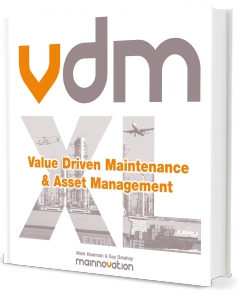How to create added value with your EAM system
ArticlesA well-stocked Enterprise Asset Management (EAM) system is invaluable for the maintenance department. The possibilities of current EAM systems – which are called Next Gen EAM – are many. When they are used optimally and efficiently, they offer benefits that extend throughout the organisation.
Developers of EAM systems have not been idle in the past years. Thanks to Internet of Things, sensor technology and mobile maintenance, we can enrich the EAM system more easily and quickly with data about our assets. This makes the EAM system an important basis for further digitalisation, as shown by the ‘Digital Trends in Maintenance & Asset Management’ study that PwC and Mainnovation conducted in 2023.
Next Gen EAM
Next Gen EAM is surrounded by a range of applications with which a connection is possible, or of which part of the functionality is sometimes already built-in. Think of Asset Investment Planning, Asset Performance Management, Business Intelligence, Predictive Maintenance, but also Mobile, GIS and BIM integration. Yet, an EAM system is mainly used by many companies as an electronic card index and digital work order system. While integration with other digital tools and applications can significantly increase operational efficiency, improve asset reliability and deliver cost savings.
 Mobile Maintenance
Mobile Maintenance
Mobile Maintenance refers to the use of mobile devices, such as smartphones or tablets, to manage maintenance tasks and workflows in real-time. Usage leads to better efficiency and higher hands-on-tool time for technicians and it allows companies to provide the information where it is needed, because the EMS system – and therefore all required asset information – is always at hand. The mobile application also boosts data quality through the mandatory input fields in the system. Due to the great ease of use, these fields are filled in quickly and easily so that the EAM system is enriched. Maintenance teams can quickly access the information they need to make well founded decisions, reducing downtime and improving the quality of maintenance activities.
Work order registration
The research ‘Digital Trends in Maintenance & Asset Management’, by PwC and Mainnovation, has shown that many companies have embraced mobile maintenance. The study also indicated what this technique is used for. The functionality that stands out the most is: work order registrations (70%). Technicians can easily prioritise tasks based on asset criticality and resource availability, leading to more efficient use of resources. In addition, companies also choose to use mobile devices for inspections (42%). The big advantage of a mobile device is that you can immediately take photos and upload them to the EAM system, on the spot.
Link with ERP
Packages from current developers of EAM systems often already have good integration with ERP. This integration enables seamless communication between departments, aligning maintenance activities with broader business objectives.
The middleware (the software between an operating system and the applications running on it) has been greatly improved and the integration options have been standardised. The most common interfaces with ERP are in the financial and logistics areas. These interfaces are fairly easy to realise. However, there is a pitfall that too much is ‘reprogrammed’, so that at some point the system can no longer process updates. This must be prevented by first standardising the processes across the systems and then the interface.
Predictive maintenance
We also increasingly see modern EAM systems integrated with data analysis tools and Internet of Things (IoT) sensors. Based on condition-based maintenance, the maintenance department can switch from reactive to predictive maintenance. Through real-time monitoring, EAM systems can predict when maintenance is needed, reducing unexpected failures and extending the life of assets. This predictive approach not only reduces maintenance costs, but also minimises downtime.
Improve continuously
Efficient and optimal use of the EAM system is a prerequisite for continuous improvement. This improvement process starts with defining the business processes in the field of maintenance and asset management. Which steps need to be completed and who is responsible for which step? This is supported by your IT landscape, where the EAM system takes a central role. The EAM system is enriched through careful registration. And based on the better data/content (also from PdM, LTAP, FMECA and PMO), you have powerful management information at your disposal to analyse deviations and achieve goals. If we constantly use this plan-do-check-act loop, we create a continuous improvement culture.
Are you ready for Next Generation EAM? Please contact Mainnovation. Our VDMXL experts are happy to help you with all your questions regarding the further professionalisation and automation of your Maintenance & Asset Management organisation.


Social